Live in Concert with the Edmonton Symphony Orchestra
Peter Bourne on the Salvo (2009) CD
release, and much more
“… a mammoth task was set …”
“For what they are about to record, may the Lord be truly helpful."
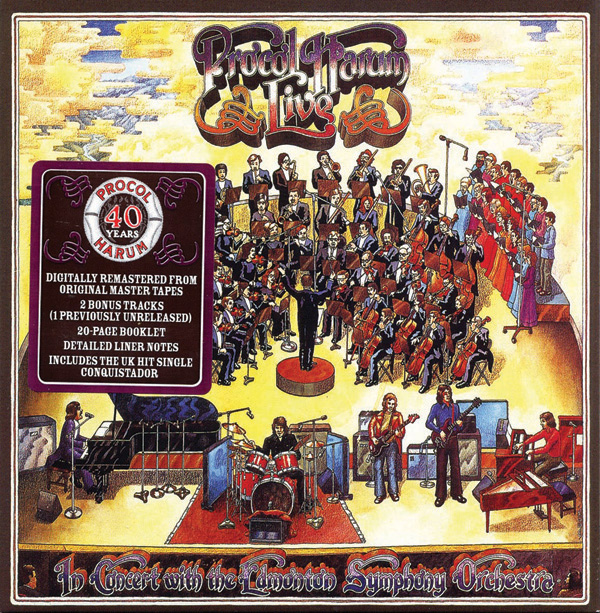 I’ve seen Procol Harum only once – at an outdoor concert on 21 August 1971 in
Montreal at the old Expo ’67 site (Place Des Nations, part of Terre Des Hommes /
Man and His World). The site was on an artificially-created island in the St
Lawrence River for Expo – Île Notre-Dame had been built in ten months from
fifteen million tons of rock excavated for the new Montreal Metro in 1965). I
guess they had to put the fill somewhere, so someone said; “Why not build an
island?”
I’ve seen Procol Harum only once – at an outdoor concert on 21 August 1971 in
Montreal at the old Expo ’67 site (Place Des Nations, part of Terre Des Hommes /
Man and His World). The site was on an artificially-created island in the St
Lawrence River for Expo – Île Notre-Dame had been built in ten months from
fifteen million tons of rock excavated for the new Montreal Metro in 1965). I
guess they had to put the fill somewhere, so someone said; “Why not build an
island?”
This show’s set-list has not been published, but I recall it was similar, if not
identical, to that of the
concert in St. Louis two weeks later (although in Montreal they did A
Whiter Shade of Pale either in the concert or as an encore, in addition to
Repent). The opening number (Shine on Brightly) suffered a
vocal mic problem for about the first half of the song, but the rest of the
concert came off without a hitch. There are, however, some great stills of the
pre-concert
stage setup – my wife and I sat about halfway up in the bleachers at the
right (ie stage left) of the second picture. We had a great view of the band
(except only a back view of Copping). It was an excellent concert – the sound
(once they fixed it) still mostly sucked (it was the early 70s, after
all, and it was outdoors!), but it was a beautiful evening. And … it was
Procol Harum. And we didn’t know that the sound sucked (nor did we care).
Little did we know that fourteen days earlier leader Gary Brooker, along with
Edmonton Symphony Orchestra ('ESO') Assistant GM Bob Hunka and Procol’s road
manager Derek Sutton, had met to arrange a concert recording with the ESO for
the following November 18. Hunka, who knew of Procol’s successful experience
with an orchestra at the annual Stratford (Ontario) Shakespeare Festival two
years earlier, had been approached twice before, earlier that year, about the
possibility that Procol might collaborate with the ESO, who had some previous
experience (though not with the current conductor!) with rock bands (such as
Lighthouse, a Toronto jazz-rock band – whose sax player was Howard Shore – yes,
that Howard Shore). The first suggestion came from Holger Petersen – a DJ
and part-time Edmonton CBC employee, later founder of the respected roots label
Stony Plain Records, who suggested to Hunka that Procol Harum and the orchestra
would be a natural fit; this idea was later reinforced by the respected Canadian
critic Ritchie York, who must have convinced Hunka to seriously consider the
proposal, and the 7 August meeting sealed it.
I still worked my job selling records in 1971, and I heard from someone at the
time of the Edmonton concert; there were rumours of a recording. So you can
imagine my delight when the album was released in the spring of 1972. The
concert (18 November 1971) was performed by the same band I had seen earlier:
Gary Brooker (piano/vocal), Chris Copping (Hammond organ/harpsichord), Alan
Cartwright (bass), Dave Ball (guitar), BJ Wilson (drums), not to forget the
‘words guy’ and occasional performer, Keith Reid. The original album selections
released on LP and tape were: Conquistador (from Procol Harum),
Whaling Stories (from Home), A Salty Dog, All This and More
(from A Salty Dog), and In Held ’Twas In I (from Shine on
Brightly). Bonus tracks on the Salvo CD include Luskus Delph (from
Broken Barricades), recorded from the concert, and two rehearsal tracks
Simple Sister (also from Broken Barricades) and Shine on Brightly
from the 1968 album of that title.
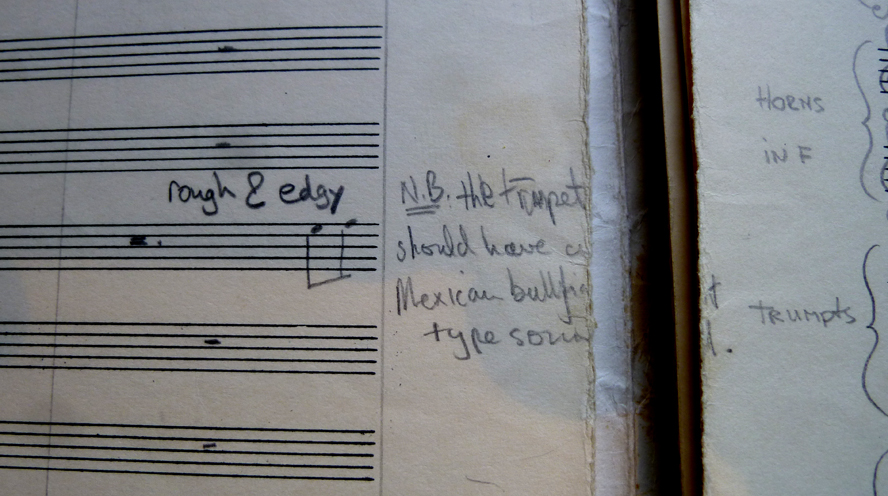 The legendary Wally Heider, who was brought in from LA to engineer, set up his
mobile 16-track recorder in the green room offstage. Chris Thomas, producer of
Procol’s previous two albums (Home and Broken Barricades) reprised
his rôle here, and would go on to produce Grand Hotel and Exotic Birds
& Fruit as well. The fifty-odd piece ESO (one publicity poster boasts ‘a
77-man [sic] group’! – I suppose they included the choir) was conducted
by Lawrence Leonard, who was reportedly none too pleased by the thought of
sharing the stage with a rock band! Notably, his name wasn’t credited on the
original LP; highly unusual, as any conductor I’ve ever known has always
insisted that his name be credited – usually in lights! (ie “ESO conducted
by…”). Perhaps he asked that it not be published, fearing for his career with
such an association (these days, conductors and indeed classical musicians are a
lot mellower outside their ‘box’). Clearly, the previous experience the ESO had
had was led by a different conductor! Finally, the semi-professional Da Camera
Singers provide enthusiastic and inspired choral accompaniment.
The legendary Wally Heider, who was brought in from LA to engineer, set up his
mobile 16-track recorder in the green room offstage. Chris Thomas, producer of
Procol’s previous two albums (Home and Broken Barricades) reprised
his rôle here, and would go on to produce Grand Hotel and Exotic Birds
& Fruit as well. The fifty-odd piece ESO (one publicity poster boasts ‘a
77-man [sic] group’! – I suppose they included the choir) was conducted
by Lawrence Leonard, who was reportedly none too pleased by the thought of
sharing the stage with a rock band! Notably, his name wasn’t credited on the
original LP; highly unusual, as any conductor I’ve ever known has always
insisted that his name be credited – usually in lights! (ie “ESO conducted
by…”). Perhaps he asked that it not be published, fearing for his career with
such an association (these days, conductors and indeed classical musicians are a
lot mellower outside their ‘box’). Clearly, the previous experience the ESO had
had was led by a different conductor! Finally, the semi-professional Da Camera
Singers provide enthusiastic and inspired choral accompaniment.
There’s a lot of behind-the-scenes stuff, some in the Patrick Humphries liner
notes for the 2009 Salvo CD release (which reproduces the fabulous album
cover by Bruce Meek), and thoroughly documented in the extensive BtP pages (here
and
here, for example). There are a few tidbits worth highlighting:
·
Gary in the original liner notes mentions “one and a half days of recording” –
did he mean rehearsals? – which would have been more in keeping
with the various accounts and diaries, although, as it turned out, there were
recordings of at least some of the rehearsals
·
The audience were treated to a
‘warm-up’ solo performance, of the famous Adagio di Albinoni, by the
organist, ‘Professor’ Chris Copping with the ESO’s strings (according to
Melody Maker, this performance was ‘a brave try’). It’s a real shame that
this bit was apparently not recorded (or if so, never released)
Neither, seemingly, were the ‘one and a
half days of recording’: the ESO’s principal oboist was also the music union
shop steward, and in this capacity insisted the rehearsals could not be
recorded, as that would constitute a violation of the musicians’ contract. From
the Circus magazine article on the concert:
‘…The Union representative at first demands that the recording machine not be
used until the actual concert, making it impossible for the engineers to set
their sound level. Procol and the engineers make their point, and the machines
are turned on for rehearsal; but the Union man continues his harassment. He sits
through rehearsal with a stopwatch and when time is up pulls the orchestra off
the stage ... in the middle of a song.’
As it turned out, somehow some of the rehearsals (at least the two bonus tracks)
were successfully recorded, despite the Union man’s best efforts.
Another significant problem (eventually overcome, either by fiat or by
truce) was that of communication between the band and the orchestra: Gary and
the conductor apparently did not get on at first, according to Gary’s
diary:
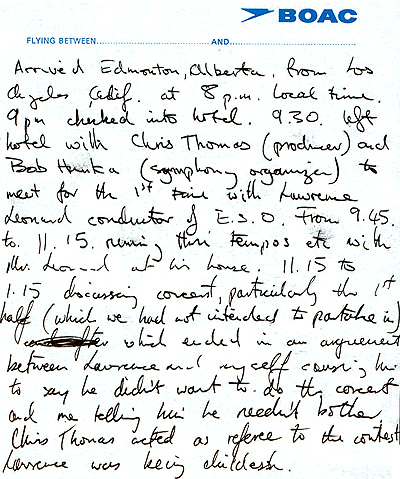 “11.15 to 1.15 – discussing concert, particularly the 1st half (which we had not
intended to partake in) and after which ended in an argument between Lawrence
and myself causing him to say he didn't want to do the concert and me telling
him he needn't bother. Chris Thomas [producer] acted as referee to the contest:
[the conductor] was being childish…”
“11.15 to 1.15 – discussing concert, particularly the 1st half (which we had not
intended to partake in) and after which ended in an argument between Lawrence
and myself causing him to say he didn't want to do the concert and me telling
him he needn't bother. Chris Thomas [producer] acted as referee to the contest:
[the conductor] was being childish…”
A crucial issue was eye-contact with the conductor (for cues, etc): although
four of the band could see the conductor (and vice versa), BJ (whose kit
was placed directly in front of the conductor’s podium; ie ‘behind’ the
conductor facing his orchestra) was unable to make eye- contact with either the
conductor or the concertmaster. Solution? Someone (probably a stagehand or
roadie) came up with a truck side-view mirror and gaffer-taped it to one of BJ’s
cymbal stands and focused it on the conductor. And Bob’s your uncle! No video
monitors in those days, but ... necessity … mother of invention, right?
To add to the stress, most of the band’s equipment (coming from LA) had been
held up at Canadian customs, so most of the rehearsals were restricted to
orchestra with Gary on piano. No choir, because they were unavailable for
daytime rehearsals, the majority being amateurs with day jobs! And, paraphrasing
Gary’s response to BJ when the latter expressed concern about the orchestra’s
“difficulties” during rehearsal, “… previous experience … has shown … that
symphony musicians tend to save their best until the performance” (from the
liner notes). As the saying goes, ‘Bad rehearsal, good show.’
So, with very little pre-production time together, the band, orchestra and choir
sallied forth that chilly November evening (it was Canada, folks!): first, the
Adagio with Copping and the strings, and then the show opened with some
(partly intelligible) mumbling by Gary, and the orchestra launched into the
now-familiar opening of Conquistador, with the insistent strings
punctuated by the (now-familiar) mariachi / bullfighter trumpet theme, and the
concert was under way. This performance, of course, was to become eventually
their second best-selling single. Ironically, Conquistador had not been
run through with the orchestra, as the individual orchestra parts had not
arrived in time for the afternoon rehearsals. It could have been a disaster,
but, despite the setback, they decided to go ahead, and it worked - brilliantly!
(Some – many, perhaps – prefer the original studio version, but you can’t argue
with the fact that the live version did become a hit single.)
From there, directly into the dramatic Whaling Stories; this was the
first chance for the Da Cameras to show their stuff (which, initially, “bordered
on the bizarre. The singers drew a laugh for their introductory shout … for
which they all rose only to promptly reseat themselves.”) The orchestra also
came up trumps: the dramatic minor-key march mid-song, with whooping French
horns and ominous brass segueing into a terrific guitar solo from the great Dave
Ball; thence modulating into the gentle major key coda (“Daybreak…”),
culminating in the duet between Gary and the Da Cameras and finally the quiet
ending. Just beautiful.
Gary then introduces A Salty Dog with a short chat about their first
experience with an orchestra on this song, and mentioning the inclusion of “a
few tweet-tweets” (the seagulls). The song uses the same orchestral arrangement
(with a few tweaks) as the original studio recording – the result is remarkably
similar. There have since been many now legendary performances of this, their
masterpiece (some say).
All This and More
starts off as we remember it from A Salty Dog, but the choir comes in quietly at
the start of the second verse, and then powers up a bit, with the orchestra by
now joining in. Dave Ball’s guitar work here is exemplary; he is clearly a good
successor to the recently departed Robin Trower, playing his part respectful to
the original, yet with a few of his own touches.
Finally, the concert’s 'grand finale': a full In Held ’Twas In I, the
music for which was co-composed by Brooker and former organist Matthew Fisher.
This is the song (suite/oratorio) that, for me, elevated Procol Harum into the
realm of ‘art-rock’ (I avoid the term ‘progressive rock’ as I never think of
Procol that way).
 The first part (Glimpses of Nirvana) consists of two recitatives; the
first (“In the darkness of the night…” – Gary) ends with the famous “Life is
like a beanstalk, isn’t it?” followed by the dramatic guitar/drums passage, then
a quiet tune (employing oboe instead of sitar – very effective) with
wordless ‘oooh’ chorus, and contemplative piano playing, followed by “Held close
by that which some despise…”); ie the second recitative, featuring a rare vocal
performance by Keith Reid. The second ‘chapter’ (’Twas teatime at the circus!),
a bouncy, almost music-hall type song (partly about Jimi Hendrix!), involved the
choir tunelessly ‘sing-saying’ the first verse, alternating with Gary’s vocal.
In the second verse of ’Twas, there’s a marvellous tuba line under Gary’s
vocal, punctuated by some raucous trombone glissandi and rhythmic whoops
from the choir. It ends with the choir (and perhaps some of the audience!)
clapping and cheering.
The first part (Glimpses of Nirvana) consists of two recitatives; the
first (“In the darkness of the night…” – Gary) ends with the famous “Life is
like a beanstalk, isn’t it?” followed by the dramatic guitar/drums passage, then
a quiet tune (employing oboe instead of sitar – very effective) with
wordless ‘oooh’ chorus, and contemplative piano playing, followed by “Held close
by that which some despise…”); ie the second recitative, featuring a rare vocal
performance by Keith Reid. The second ‘chapter’ (’Twas teatime at the circus!),
a bouncy, almost music-hall type song (partly about Jimi Hendrix!), involved the
choir tunelessly ‘sing-saying’ the first verse, alternating with Gary’s vocal.
In the second verse of ’Twas, there’s a marvellous tuba line under Gary’s
vocal, punctuated by some raucous trombone glissandi and rhythmic whoops
from the choir. It ends with the choir (and perhaps some of the audience!)
clapping and cheering.
The third part of the suite is entitled In the Autumn of my Madness,
originally voiced by Matthew Fisher, now by Gary. There’s the thunder opening, a
little orchestra, and lots of guitar and Hammond organ. In the fourth part,
Look to your Soul, Gary sings (accompanied by Copping’s harpsichord), “I
know if I’d been wiser …” – a look back, with some regret … then “… some say
that I'm a wise man, some think that I'm a fool. It doesn't matter either way:
I'll be a wise man's fool …” Remember, these are Keith Reid’s words; his
preoccupation with death (already evident in earlier material like Something
Following Me) was starting to gel (“… I must spend my life amongst the dead,
who spend their lives in fear of a death that they're not sure of …”),
eventually leading to Home (which I’ve always thought of as Procol’s
Great Death Album).
Finally, the end, the wordless summing-up, the finale, appropriately enough
called Grand Finale. After the lovely piano intro (reminiscent of a Haydn
piece), there’s full band, choir and orchestra, and the ending wordless chorale.
It’s all very Church-of-England sounding, an absolutely stirring, triumphant
conclusion – I’d go so far as to say positively symphonic (reminded me, upon
first hearing, of the choral movement of Beethoven’s Ninth)! The
combination of choir and piano at the very end is positively magnificent, one of
those moments that brings tears to my eyes every time I hear it.
This concert version of In Held is better than the original studio
recording from Shine on Brightly, chiefly because of the choir and
orchestra; the suite had always cried out for this treatment. I remember when I
first heard Shine on Brightly (my account of that
here), it occurred to me at the time that this in particular number could
have benefited from orchestra and choir accompaniment. So, obviously, did
Procol, as they performed it at the above-mentioned Stratford Festival (which I
had been unaware of). Needless to say, it’s my preferred version (although some
say BJ’s drumming was a little better controlled in the studio version; I’m not
sure if I agree).
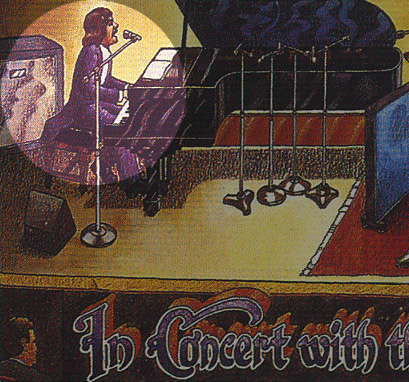 Generally, then, three of the five selections here improve upon the originals,
mainly because of orchestral and/or choral embellishments. I don’t think this
Conquistador is necessarily any better than original version on the Self-Titled (1967)
album, but Whaling Stories and All This and More do benefit
from the choir and orchestration, and In Held ’Twas In I is in another
league (except maybe for BJ’s drumming, as noted above).
Generally, then, three of the five selections here improve upon the originals,
mainly because of orchestral and/or choral embellishments. I don’t think this
Conquistador is necessarily any better than original version on the Self-Titled (1967)
album, but Whaling Stories and All This and More do benefit
from the choir and orchestration, and In Held ’Twas In I is in another
league (except maybe for BJ’s drumming, as noted above).
Finally, when the concert finished, producer Chris Thomas came rushing in from
the green room to say that a few things needed to be fixed – the orchestra’s
percussionists were sometimes behind the beat, for instance. So In Held
was re-recorded (along with Conquistador and Whaling Stories, for
whatever reasons) as true concert ‘encores’ – and the audience was welcome to
stay (what a bonus for them!). An interesting fluff - in ’Twas Teatime,
it turned out that Gary sang, “… and though the cloud crapped desperately…” It
turned out to be too difficult to simply edit out the error and drop in the
correction, given the technology of the day. So “crapped desperately” was left
on (thankfully!), as it was considered a minor error compared to whatever other
errors there were in the first take. According to Humphries’s notes, a lot of
editing generally had to be done post-production (Thomas: “… [The tape] looked
like a zebra crossing…”), including Dave Ball overdubbing a new guitar solo for
Conquistador. Incidentally, post-production editing on live albums,
including studio overdubs where feasible, were starting to become common – many
live rock albums from the ’70s got ‘fixed’ (famously, the Allman Brothers’
Band’s Fillmore East, Little Feat’s Waiting for Columbus,
the Who’s Live at Leeds, the Stones’ Ya-Yas, the
Band’s Rock of Ages, all among the best live albums ever,
were notoriously full of ‘corrections’).
This is one of the great live rock albums (although not deemed good enough to
make it on to Rolling Stone’s ‘All-time 50 Best Live Recordings’ list,
nor NME’s nor Classic Rock’s – but who cares, frankly?), and was
Procol’s only one officially released during their first decade. I suppose the
success of the album may have been partly due to the increasing popularity of
the live format; recording techniques were becoming more sophisticated, concert
sound engineers were starting to get things under control, and the increasing
use (although not here) of better electronic instruments (eg polyphonic
synthesisers) was enabling bands to reproduce their studio sound on stage, which
had been a problem in the late ’60s for bands like Cream and certainly the
Beatles. Crucially, by 1972, ‘album rock’ was gravitating to the more free-form,
less playlist-oriented FM radio band (‘Rock Radio’), with (relatively) high
fidelity, sometimes broadcast in stereo sound, whereas hitherto tinny-sounding
AM transistor and car radios were how we listened to rock music. Also,
high-fidelity sound reproduction equipment was becoming increasingly affordable;
high-end equipment had previously been possessed by only a very few. Also,
better LP pressings were increasingly in demand because of the increasing
sophistication and availability of stereo record-playing equipment (LP
pressings, especially in Canada
and the US
in the
60s, were notoriously terrible). The mono days were over (until the recent ‘Back
to Mono’ revival and the appreciation of monaural sound, of course).
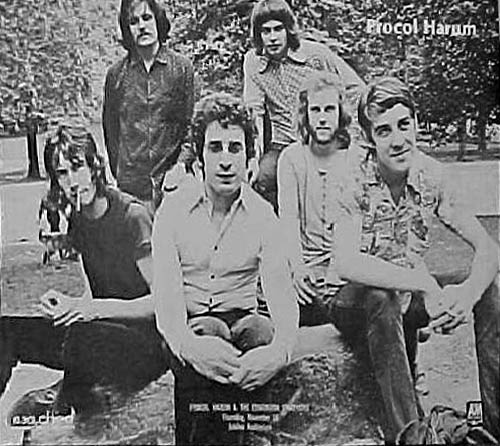 Perhaps the most significant thing about Edmonton was that, for
Procol Harum, it was (it had to be) a game-changer. Although they had
released five albums and a small handful of hit singles, they weren’t doing
particularly well by 1971, at least at home; their touring successes and record
sales were mostly in the USA. The pressure was on to sell 150,000 copies of the
live album to break even (BJ Wilson: “It’s going to be good … it had better
be good.”). That minimum, in the end, was easily achieved – the album eventually
earned a US Gold Disc, Conquistador was a US Top 20 hit, as was the album
(both reaching #5), and the album landed in the UK Top 50. Note: chart placement
reporting is nearly always wrong somewhere; I make no claim to accuracy. The
decision to pull Conquistador off the album and release it as a single
was critical as it generated AM radio play, and the album in turn benefited from
this.
Perhaps the most significant thing about Edmonton was that, for
Procol Harum, it was (it had to be) a game-changer. Although they had
released five albums and a small handful of hit singles, they weren’t doing
particularly well by 1971, at least at home; their touring successes and record
sales were mostly in the USA. The pressure was on to sell 150,000 copies of the
live album to break even (BJ Wilson: “It’s going to be good … it had better
be good.”). That minimum, in the end, was easily achieved – the album eventually
earned a US Gold Disc, Conquistador was a US Top 20 hit, as was the album
(both reaching #5), and the album landed in the UK Top 50. Note: chart placement
reporting is nearly always wrong somewhere; I make no claim to accuracy. The
decision to pull Conquistador off the album and release it as a single
was critical as it generated AM radio play, and the album in turn benefited from
this.
Success (at home and abroad) must have reinvigorated the band, as they went on
to record the acclaimed Grand Hotel (a bit of a throwback to the
‘old’ Procol Harum, especially the ornate title cut), with Mick Grabham,
last-minute replacement for guitarist Dave Ball, and three more well-regarded
albums, before disbanding in 1977. It was a shame Dave didn’t stay; Edmonton
is the only recording where we hear him (other than on a bonus track on Grand
Hotel, on which he also
plays on some of the backing tracks). He was still working his way in at the
time of the recording, but he certainly played well in Edmonton (and in Montreal
a couple of months earlier when I saw him). But, for whatever reasons, it didn’t
work out.
Since Edmonton, of course, there have been other recorded live
performances, notably, the Copenhagen (2001) DVD, the
Ledreborg Palace (Denmark
2006 – CD and DVD) and Union Chapel (2003) shows (on CD and DVD), plus others
which, although usually good performances (authorised or not!), vary in
technical quality. The Union Chapel CD has fewer selections than the DVD, as
does the 2006
Ledreborg Palace
CD. Note that the latter DVD also contains a bonus of six selections from 1974,
a performance that appears to have been taped in someone’s living room in
Copenhagen! This has Mick Grabham on guitar and BJ Wilson on drums – a real
bonus. But none share pride of place with Edmonton, if only because it
was the first authorised recording with orchestra and choir, and has become so
cherished by so many over the years.
It’s
interesting to note the progress in attitudes, if nothing else, in two years. The
reviews of the 1969 Stratford concert were decidedly mixed, to be charitable
– an excerpt from one: “Unfortunately
the [sic] Procol Harum, guest performers at the Stratford concert … have
no conception of rhythm and its immense possibilities. There was nothing but an
incessant pounding of drums and cymbals in a vain effort to cover the inadequacy
of rhythm, form and even material.” Clearly, there was a bit of a classical/pop
gap there – ‘no conception of rhythm’? Please ignore that, BJ, and continue to
rest in peace – on behalf of all Canadians, I most humbly … etc. A little
progress, maybe, from music critic William
Littler
of the Toronto Star (whose article entitled Bach, blues and snobs like
me) said, ‘…There are fresh ideas in In Held ’Twas in I, some moments
of clever irreverence, but they are vitiated by pseudo-sophisticated echoes of
Beethoven, Bach, Handel and company. What could be more antithetical to the
primitive strength of rock than piano bridges of watered-down Moonlight
Sonata and a choral finale, complete with trumpets blaring – a veritable
Hallelujah Chorus?’ Compare these sentiments with, for example, ‘…
Rhythmically interesting and accompaniments that were not just note-for-note
harmonies,’ wrote iconic Edmonton Journal classical critic Keith Ashwell.
In his review of the 1971 concert even he admitted was a bit out of his depth.’
The idea of rock groups with classical orchestra had come a fair distance.
Salvo bonus tracks: interesting, but nothing particularly special about any of
the three tunes, although Dave Ball played terrific guitar on both rehearsal
tracks. Luskus Delph had been part of the concert, but was ‘left off the
album for reasons of space’ (from the booklet notes) – it was later released as
the B-side to the single release of Conquistador. In my view, it could
have easily fitted timing-wise on the original LP. Perhaps it was left off
as a “bad fit” musically? A rehearsal of Repent Walpurgis was reportedly
taped as well, but doesn’t appear, even though there was plenty of room.
The Salvo CD is highly recommended, for all the reasons noted. There is also a
2-LP set, released recently in a gatefold sleeve (which seems to contain at
least some of the Humphries CD liner notes). The records are pressed on 180
gramme white vinyl. The LP set appears to duplicate the Salvo CD selections: it
includes the identical tracks as the CD. The original album “Side 1” is split
into the two sides of the first LP; Side 3 contains In Held ’Twas In I
and Side 4 has the CD bonus tracks. I’ve not heard this LP version, but I’ll bet
it’s good.
It is unlikely that Edmonton will be re-released. Procol’s entire
catalogue up to Something Magic was remastered for Salvo, while only the
first four albums, which had been originally released on Regal Zonophone, have
been more recently released on Esoteric Recordings. All other albums (from
Broken Barricades to Something Magic) had been released
on LP on Chrysalis; the 40th Anniversary Salvo releases appear to be
the only recordings still in print for them. Anything can happen, of course (and
it would be nice to have a double CD of Edmonton containing all
the rehearsal material and concert outtakes). But until then, we’ll have to be
satisfied with the Salvo CD (or the equivalent new LP set), and that’s pretty
fine indeed!
©
Peter Bourne November 2015
Many more pages devoted to the Edmonton
concert
 I’ve seen Procol Harum only once – at an outdoor concert on 21 August 1971 in
Montreal at the old Expo ’67 site (Place Des Nations, part of Terre Des Hommes /
Man and His World). The site was on an artificially-created island in the St
Lawrence River for Expo – Île Notre-Dame had been built in ten months from
fifteen million tons of rock excavated for the new Montreal Metro in 1965). I
guess they had to put the fill somewhere, so someone said; “Why not build an
island?”
I’ve seen Procol Harum only once – at an outdoor concert on 21 August 1971 in
Montreal at the old Expo ’67 site (Place Des Nations, part of Terre Des Hommes /
Man and His World). The site was on an artificially-created island in the St
Lawrence River for Expo – Île Notre-Dame had been built in ten months from
fifteen million tons of rock excavated for the new Montreal Metro in 1965). I
guess they had to put the fill somewhere, so someone said; “Why not build an
island?”



